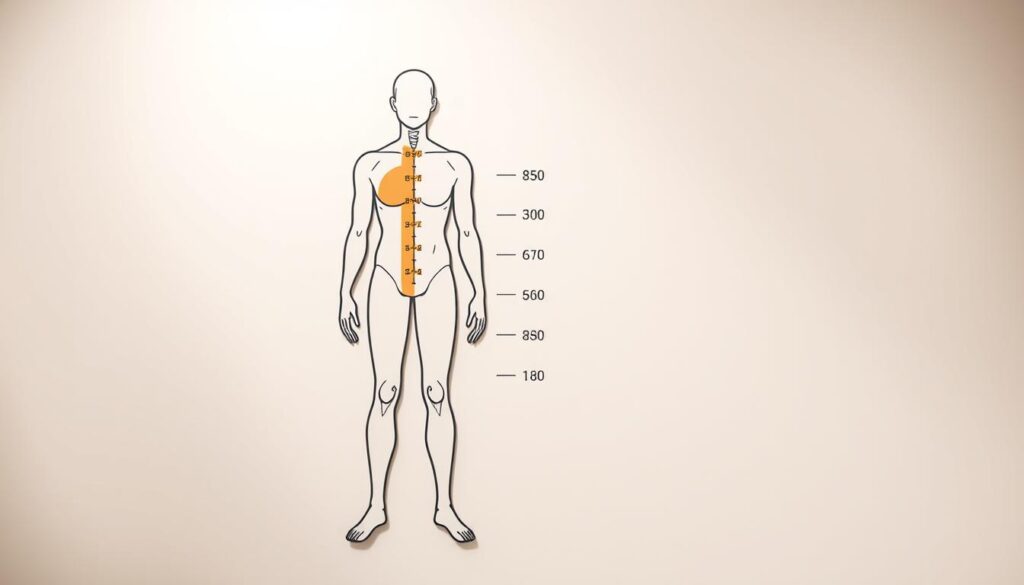Are we relying too heavily on Body Mass Index to diagnose eating disorders?
Body Mass Index (BMI) has been a main tool for health checks and diagnosing eating disorders for years. But, it has its limits. These can cause wrong assessments and late diagnoses.
We will look into the complex tie between BMI and eating disorders. We’ll talk about the downsides of using BMI for diagnosis and its effects on mental health.
Key Takeaways
- The limitations of using BMI in diagnosing eating disorders.
- The complex relationship between body mass index and mental health.
- Alternative approaches to diagnosing eating disorders.
- The importance of a comprehensive assessment in mental health diagnosis.
- Potential consequences of misdiagnosis or delayed diagnosis.
Understanding BMI: Definitions and Importance
BMI, or Body Mass Index, is a key tool in health checks. It helps sort people into weight groups like underweight, normal, overweight, and obese.
What is BMI?
BMI is a simple formula: weight in kilograms divided by height in meters squared (kg/m2). It shows if a person’s weight is healthy for their height.
How is BMI Calculated?
To find BMI, divide weight in kilograms by height in meters squared. For instance, a 70 kg person who is 1.75 m tall has a BMI of 22.86.
For more info, check out the National Center for Biotechnology Information or Health Weight Calculator for weight management tips.
The Relevance of BMI in Health Assessments
BMI is useful in health checks because it quickly spots weight-related health problems. But, it has its limits, like not counting muscle or body fat.
- BMI can be off for athletes or those with lots of muscle.
- It can’t tell the difference between lean body mass and fat.
- It might not show health risks for everyone, like older adults or certain ethnic groups.
Even with its flaws, BMI is still useful in public health and clinics. It helps spot weight issues and guide further checks or actions.
The Link Between BMI and Eating Disorders
The relationship between BMI and eating disorders is complex. It’s influenced by many factors like emotional eating, mental health, and cultural views. To understand this link, we need a detailed approach.
How BMI Influences Eating Behavior
BMI can greatly affect how we eat. People with higher or lower BMIs may feel pressured to meet certain body standards. This can lead to unhealthy eating habits like emotional eating or restrictive eating.
Studies show that those with higher BMIs often feel unhappy with their bodies. This can cause them to eat in unhealthy ways. On the other hand, people with lower BMIs might develop eating disorders like anorexia nervosa.
Recognizing Eating Disorders Related to BMI
It’s important to know the signs of eating disorders linked to BMI. For example, very low BMIs can lead to malnutrition and health problems. This is often seen in anorexia nervosa.
People with higher BMIs might struggle with binge eating disorder. This is when they eat too much and feel guilty or out of control. Spotting these disorders early is key to helping them.
Gender and Cultural Influences on BMI Perception
Gender and culture greatly affect how we see BMI and body image. Beauty standards vary by culture and can lead to body dissatisfaction and unhealthy eating. For example, some cultures idealize a thinner body, which can harm individuals trying to meet this standard.
Gender also plays a part in BMI perception and eating habits. Women, for instance, often face more pressure to meet beauty standards. This can lead to body dissatisfaction and eating disorders.
Common Eating Disorders and Their Impacts
Eating disorders like anorexia nervosa, bulimia nervosa, and binge eating disorder affect both mind and body. They are complex and need a full treatment plan. This plan includes medical, nutritional, and psychological support.
Anorexia Nervosa
Anorexia nervosa makes people see their body differently and fear weight gain. They eat very little and lose a lot of weight. This can cause serious health problems like osteoporosis and heart issues. Treatment often includes medical care, nutrition advice, and therapy.
Bulimia Nervosa
Bulimia nervosa is when people eat a lot and then try to make up for it by vomiting or using laxatives. This can harm their health, causing problems like tooth decay. Good treatment includes therapy and learning about healthy eating.
Binge Eating Disorder
Binge eating disorder means eating a lot of food quickly, feeling guilty and out of control. It can lead to obesity and diseases like diabetes. Getting help from a dietitian is key to treating this, helping to change how people see food and their body.
It’s important to understand these eating disorders and their effects. We need to seek professional help, like therapy and nutrition advice, to help those affected.
The Psychological Aspects of BMI and Eating Disorders
The psychological aspects of BMI and eating disorders are complex. They involve body image, mental health, and eating behaviors. Understanding these factors is key to treating eating disorders.
Body Image Distortion
Body image distortion is a big part of eating disorders. People with these disorders see their bodies differently than others do. This can lead to unhealthy eating and mental health problems.
This distortion comes from many places. It’s influenced by what society says is beautiful, what the media shows, and personal experiences.
Research shows that those with distorted body images often have disordered eating. Studies highlight the need to tackle body image in treating eating disorders.
The Role of Mental Health
Mental health is crucial in eating disorders. Depression, anxiety, and obsessive-compulsive disorder often go hand in hand with eating disorders. It’s important to understand how mental health and eating disorders interact for effective care.
Building a healthy relationship with food is key to recovery. This means changing how you eat and dealing with the psychological issues. Nutrition counseling can help by teaching about balanced nutrition and how to achieve it.
Seeking Help and Support
Getting help is a big step in dealing with BMI and eating disorders. This can mean seeing therapists, nutritionists, or other healthcare professionals. Support groups, online or in-person, offer valuable connections and resources for those affected by eating disorders.
By recognizing the psychological aspects of BMI and eating disorders and getting help, people can work towards recovery. They can develop a healthier relationship with food and their bodies.
Assessing BMI: Limitations and Critiques
BMI has its limits, leading to wrong health assessments. It shows if a person’s weight is healthy for their height. But it doesn’t measure body fat or muscle, bone density, or body composition.
Why BMI is Not Always an Accurate Measure
BMI is found by dividing weight in kilograms by height in meters squared. This simple formula doesn’t tell the difference between muscle and fat. For example, a bodybuilder might have a high BMI without being too fat.
BMI also doesn’t look at where body fat is stored. Visceral fat, around organs, is riskier than fat elsewhere. So, two people with the same BMI can have very different health risks.
Alternative Ways to Assess Health
Healthcare experts are looking for better ways to check health. Some options include:
- Measuring waist circumference to check visceral fat
- Dual-energy X-ray absorptiometry (DXA) scans for bone density and body composition
- Hydrostatic weighing to find body density
- Air displacement plethysmography (ADP) for body volume
These methods give a deeper look at health, beyond BMI’s simple height-weight ratio.
The Importance of Individual Context
It’s key to think about individual factors when checking health. Age, gender, ethnicity, and activity level all play a part. For instance, older adults might have more body fat for a given BMI than younger people.
Healthcare providers can give better care by looking at more than just BMI. They should consider lifestyle, medical history, and body composition too.
Prevention and Early Intervention Strategies
Preventing eating disorders requires a mix of promoting healthy body images, teaching nutrition, and community programs. By focusing on these areas, we can lower the risk of eating disorders.
Promoting Healthy Body Image
It’s key to promote a healthy body image to prevent eating disorders. We need to help people, mainly young ones, see their bodies positively. This can be done through media literacy programs and teaching them to question media’s beauty standards.
Positive role modeling is also crucial. Parents, teachers, and influencers should celebrate all body types. This creates a space where everyone feels valued and accepted, no matter their looks.
Education on Nutrition and Health
Learning about nutrition is essential for a healthy relationship with food. Knowing about nutrition helps people make better food choices, lowering eating disorder risks. Nutrition counseling offers personalized advice and support.
| Nutrition Education Topics | Key Takeaways | Benefits |
|---|---|---|
| Understanding Macronutrients | Knowledge of carbohydrates, proteins, and fats | Informed dietary choices |
| Healthy Eating Habits | Practices for balanced eating | Improved overall health |
| Nutrition and Mental Health | Link between diet and mental well-being | Enhanced mental health support |
Community-Based Support Programs
Community support programs are key for treatment options and help for those with eating disorders. They offer support groups, workshops, and online forums for sharing and getting help.
By using these strategies together, we can fight eating disorders effectively. It’s about building a culture that values health over looks and supports people in their journey to a healthier food and body relationship.
Resources and Support for Individuals and Families
Dealing with eating disorders is tough. It needs good resources and support. People and families facing these issues can find help through various treatments and expert advice.
Professional Help: Therapists and Nutritionists
Getting help from mental health experts, like therapists, is key. They tackle the emotional side of eating disorders. Dietitians also offer tailored nutrition plans to help with healthy eating and recovery.
Effective treatments include cognitive-behavioral therapy (CBT) and family-based therapy (FBT). These methods help manage eating disorders well.
Online Support Groups and Hotlines
Online groups and hotlines offer quick help and a community feeling. Places like the National Eating Disorders Association (NEDA) have resources. They include online groups and a helpline to help with eating disorders.




